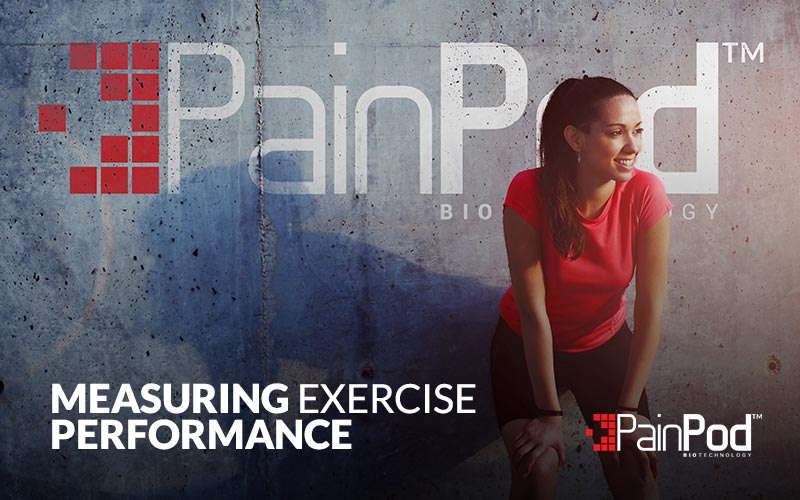Workout With PainPod
Have you ever wished you could cycle uphill faster or maintain 100% max performance for longer when working out?
If you’re among the 1 in 2 Americans participating in exercise, PainPod™ may well be the perfect workout tool to help you reach your fitness goals - fast.
Clinical research has recently revealed PainPod™ medical technology can assist with optimizing and enhancing exercise outcomes(1) simply by adding it into your fitness routine.
How do we know PainPod™ can improve exercise performance? Let’s take a closer look at the clinical research to find out...

How is exercise performance measured?
Cycle Ergometer Test
During the research study a cycle ergometer was used in the exercise tolerance test. The participants had to maintain a pedaling rate of 60–70 rpm until they reached their limit of tolerance. TENS or placebo TENS (inactive TENS) was applied for 30 minutes prior to the test as well as during the exercise test.
Each participant visited the testing laboratory on three occasions, sometimes receiving the active treatment and sometimes receiving the placebo treatment. In this way, no control group was necessary, as each person acted as their own control (this is called a case-crossover study design).
Let’s get technical: research study breakdown
The researchers measured oxygen uptake and exercise efficiency in 11 healthy males with an average age of 21 years.
They found that these measures were improved when subjects received TENS (transcutaneous electrical nerve stimulation) before and during the exercise test, compared to when they received ‘placebo’ TENS (1) which was not an active TENS current.
The findings were published in the International Journal of Sports Medicine. Dr Fernanda Tomasi reported:
“Our data shows that the application of TENS can potentially increase exercise tolerance and oxygen supply in healthy subjects.”
Oxygen uptake during the exercise test was also significantly higher and carbon dioxide levels were significantly lower when the participants received TENS compared to when they received the placebo (inactive TENS P < 0.05).
TENS also increased mechanical efficiency and exercise tolerance compared to placebo (P < 0.05).
How does TENS improve exercise performance?
Dr Tomasi explained that TENS works by decreasing the levels of epinephrine (adrenalin) and noradrenalin.
“These factors collectively contribute to the reduction of heart rate, increasing oxygen pulse during exercise without impairing exercise tolerance,”
explained Dr Tomasi. In other words, TENS allows you to work even harder than normal during exercise, by reducing your heart rate and increasing your oxygen pulse.
Other studies have found that TENS also produces significant dilation of the peripheral blood vessels which in turn improves the oxygen delivery to muscles (2). This adds further to evidence of the possible benefits of PainPod™ advanced technology for exercise and elite sports performance enhancement.

PainPod™ recommendations to use PainPod™ for exercise performance
The PainPod™ 3 employs the latest PainPod™ proprietary biotechnology (which includes both TENS and NMES treatment technology) for enhanced pain relief and physical therapy. PainPod™’s advanced treatment technology has a number of different benefits for people and a wide range of uses.
PainPod™ proprietary medical technology is able to be adapted for use in a variety of athletic scenarios and has been successfully used in several professional sports including Australian Football League (AFL), basketball, football, hockey, golfing and martial arts to relieve pain and aid circulation of oxygen through the body (2). The PainPod™ 3 has been developed to relieve pain, aid recovery and maximize results at all stages of the regular training routine including warm-up, during training, recovery and injury rehabilitation.
Get the most out of your exercise routine and use your PainPod™ before, during and after your workout to assist with enhancing your performance and aiding your recovery.

Here are a few suggestions that could help you improve exercise performance:
- Apply PainPod™ around 30 minutes before your workout session
- If the type of exercise allows, continue to use PainPod™ during your workout
- Use PainPod™ in the evenings to reduce recovery time the following day
- If you have sore or painful muscles the day after your workout, PainPod™ can also assist with physical therapy.
Integrating PainPod™ into your exercise routine, in addition to the measures suggested above, can assist in optimizing your exercise performance and recovery.
Contraindications for PainPod™ medical devices
Do not use your PainPod™:
- if you have a pacemaker or any kind of electronic implanted device
- if you have a cochlear implant hearing device
- if you have a severe heart disorder
- if you already have DVT
If you are prone to seizures, suffer from epilepsy, are pregnant, have cancer or are recovering from cancer, consult with your doctor before use. Remember, the PainPod™ is an medical device and as such, should be used only as directed by the manual and user guide or by your healthcare professional.
References
- Tomasi et al. Transcutaneous electrical nerve stimulation improves exercise tolerance in healthy subjects. Int J Sports Med (2014) 35: 1–5.
- Vieira et al. Effect of transcutaneous electrical nerve stimulation on muscle metaboreflex in healthy young and older subjects. Eur J Appl Physiol (2012) 112:1327–1334.
PainPod™ USA encourages its customers to always read the label and to use its products as directed. If symptoms persist see your doctor and/or healthcare professional. Listed on the Australian Register of Therapeutic Goods as ARTG Identifier: 176131. PainPod™ medical devices are also FDA listed and CE marked.



